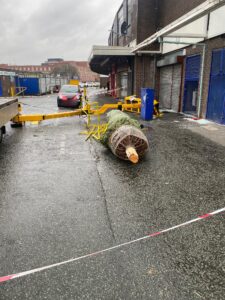• Major transport system operated for almost a decade without basic safety measures
• Council “chose to appeal enforcement action instead of acting on concerns”, says regulator
• Families pay tribute to loved ones
Cambridgeshire County Council has been fined £6 million after pleading guilty to serious safety failings on its Guided Busway that led to three deaths and multiple injuries over a ten-year period.
The prosecution follows a long and complex Health and Safety Executive (HSE) investigation, where incidents continued to happen despite regular enforcement action from the regulator.
A guided busway is purpose-built track exclusively for buses to bypass traffic congestion.
Three people died after being hit by buses on the network. Jennifer Taylor, 81, died in darkness at an unlit crossing in November 2015. Three years later beloved family man Steve Moir, 50, was killed after his bike struck a kerb, causing him to fall into the path of an oncoming bus. Kathleen Pitts, 52, lost her life in October 2021. Two young people also suffered serious injuries in separate incidents.


Despite the first fatality in 2015, the council didn’t conduct its first risk assessment until August 2016; which was five years after the Guided Busway first opened.
The HSE investigation also found that basic safety measures were missing across the busway including lighting of some crossing points, appropriate speed limits for buses, sufficient measures to separate pedestrians and other users including cyclists from passing buses, and adequate signage warning of dangers.
In a statement, Mrs Taylor’s family: “Jenny was deeply loved by all of us, and we dearly miss her.
“As a family we would like to thank the HSE for their tireless efforts in bringing this case to court. We hope that the lessons learned will lead to sustained safety improvements and help avoid tragedy, injury and suffering in the future.”
Mr Moir, an active cyclist who coached local youth football and served as a school governor, was thrown into the path of a bus travelling at 56mph after losing control on the narrow maintenance path running alongside the busway.
“The loss of Steve has left us devastated and there is now a big hole in our lives that cannot be filled,” Mr Moir’s family said in a statement following the hearing at Cambridge Crown Court.
“Steve was a loving, caring family man with a great sense of humour and a zest for life who brought laughter and joy to our lives every day and his presence is deeply missed by us all.”
Following his death, the council reduced the speed limit to 30mph in the area in question, but this failed to prevent the subsequent fatal incident involving Kathleen Pitts in October 2021.
Just three weeks after Ms Pitts’ death, a 16-year-old cyclist suffered life-changing injuries at a designated crossing point.
After the hearing, HSE principal inspector Graham Tompkins said:
“This is a truly tragic case where three people lost their lives and others suffered serious injuries in incidents that were completely preventable.
“Had Cambridgeshire County Council properly assessed and managed the risks on the Guided Busway from the outset, these deaths simply would not have happened. Even after the first fatality in 2015, the council failed to take adequate action to protect the public. They chose to appeal our enforcement action instead of acting on our concerns and incidents continued to happen.
“Simple measures could have saved lives and life changing injuries. Instead, the council operated this major transport system for almost a decade without many of the basic safety measures we see in every village, town and city being in place.
“The families of those who died have shown remarkable courage throughout this process, and I hope this prosecution brings some measure of closure for them, though nothing can make up for the loss of their loved ones.”
• Employers are required by law to protect both their employees and others from harm and assessing the risk is just one part of the overall process and HSE guidance is available to explain what steps should be taken.
Specific guidance for the designers and operators of guided busways is available from Britpave (the British In-Situ Concrete Paving Association) in the Guided Busway Design Handbook (https://www.britpave.org.uk/Publications/Bus-and-Rail/).
Graham Tompkins continued: “Our risk assessment guidance may be more commonly used for workplaces such as factories and construction sites, but the same principles apply for busy spaces such as major transport infrastructure. The possible risks to people and the movement of passengers, pedestrians and others needs to be thought through.”
Cambridgeshire County Council of New Shire Hall, Emery Crescent, Enterprise Campus, Alconbury Weald, Huntingdon pleaded guilty to two offences under section 3(1) of the Health and Safety at Work etc. Act 1974. The charges related to failing to protect the public both at crossing points and while travelling alongside the busway.
At Cambridge Crown Court on 16 April 2025 the council was ordered to pay a fine of £6 million plus £292,460.90 in costs.
Summary of key incidents
• After dark on 17 November 2015, Jennifer Taylor and her husband stepped off a bus at Fen Drayton Lakes and attempted to cross the track to get on another bus towards Cambridge. They did so at the designated crossing. As they crossed the Busway, a guided bus was on the approach. There was no lighting in this area so Mrs Taylor was not visible to the bus driver, who was travelling within the speed limit which was at the time 56mph. By the time Mrs Taylor was in sight of the bus driver, it was too late. She died at the scene.
• On 13 September 2018, Steve Moir, an experienced cyclist, was cycling along the access road that facilitates maintenance of the guided busway. The space was opened up to the public as a pedestrian pathway and cycle route by Cambridge County Council. Mr Moir was near Clare College’s sports ground when he lost control of his bicycle in busy cyclist and pedestrian traffic. His front wheel struck the raised kerb that separates the guided track and access road. He was flown over his handlebars into the path of an oncoming bus. The bus was travelling within the speed limit set by Cambridgeshire County Council, which was at this time, 56mph. The bus was unable to stop in time to avoid Mr Moir. Mr Moir died at the scene.
• On 1 May 2019, a then 12-year-old cyclist, was attempting to cross the Busway between Ring Fort Road and King’s Hedges Road when she was struck by a bus and sustained injuries requiring hospital treatment.
• On 26 October 2021, Kathleen Pitts was walking along the pathway a few hundred meters south Mr Moir’s accident near Clare College’s sports ground. She was next to the southern guided section of the Busway when she was struck by a passing bus and killed. The oncoming northbound bus which hit her had been travelling at the 30mph speed limit which was the revised limit for the that section set by Cambridge County Council after Mr Moir’s death.
• After dark on 9 November 2021 a then 16-year-old cyclist, was struck and the designated Buchan Street crossing. This left the cyclist with life changing injuries.
Investigation findings
The HSE investigation identified safety management failings within Cambridgeshire County Council for the operation of the Busway for a period of just over 10 years.
These failures related to two distinct risks; members of the public seeking to cross the Busway at designated crossing points and risks to members of the public when they were merely in its vicinity, or seeking to travel alongside it.
Despite interventions by HSE which included two Improvement Notices, Cambridgeshire County Council failed to adequately manage safety on the Busway until late 2021.
The Busway opened in 2011, but it was not until August 2016 after one death and several serious injuries on the Busway, that the first risk assessment was undertaken.
This risk assessment did not adequately assess the risk to members of the public crossing, or being alongside, the Busway. For example, in locations where the Busway was more crowded and where the adjacent access pathway was narrow, congestion was more likely. This would lead to people being jostled or unknowingly deliberately moving into the path of a bus, as in some sections there were no separators such as grass verges, physical barriers or fences to keep them to the access pathway.
Furthermore, Cambridgeshire County Council did not consider other measures to reduce the risk to members of the public, such as speed limits and the provision of lighting and suitable signage.
Further information
1. The Health and Safety Executive (HSE) is Britain’s national regulator for workplace health and safety. We are dedicated to protecting people and places, and helping everyone lead safer and healthier lives.
2. More information about the legislation referred to in this case is available.
3. Further details on the latest HSE news releases is available.
4. HSE does not pass sentences, set guidelines or collect any fines imposed. Relevant sentencing guidelines must be followed unless the court is satisfied that it would be contrary to the interests of justice to do so. The sentencing guidelines for health and safety offences can be found here.
5. Guidance on working safely with vehicles in the workplace can be found here: Introduction to workplace transport safety – HSE
6. Further information on guided busways is available in the Britpave publication Guided Busway DESIGN HANDBOOK, 2017 edition, available on their website at; https://www.britpave.org.uk/Publications.




